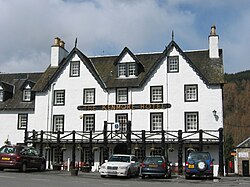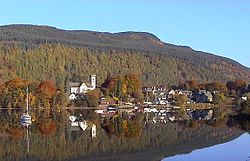inscribed " Taymouth" a page from an album inscribed in the frontispage "F W Staines 3 Uplands St Leonards on Sea"
Amelia Jackson, Nee Staines (1842 – 1925) and thence by descent
The church was built in 1760 to serve the planned village of Kenmore, which had been redeveloped here on the site of an earlier village over the period since 1755. Records suggest that in 1759 the architect William Baker of Cheshire was paid 6 guineas to produce plans for a church by the Earl of Breadalbane. These were amended (presumably with the agreement of the Earl) by the builder, George Paterson, during the construction of the church the following year.
The new church incorporated parts of its predecessor on the same site, built in 1669, but little or no evidence of the earlier building can be seen today. Kenmore Church was renovated in 1869, with the main change being a new roof and the heightening of the tower which was topped off with pinnacles. These were removed in 1950.
Kenmore is a small village in Perthshire, in the Highlands of Scotland, located where Loch Tay drains into the River Tay.
The village dates from the 16th century. It and the neighbouring Castle were originally known as Balloch (from Gaelic bealach, 'pass'). The original village was sited on the north side of river approximately two miles (three kilometres) from its present site and was known as Inchadney. In 1540 Sir Colin Campbell of Glenorchy started the construction of Balloch castle on the opposite bank of the river and the entire village was moved to a prominent headland by the shores of Loch Tay, hence the name Kenmore, which translates from Scots Gaelic to "big (or large) head". The village as it is seen today is a model village laid out by 3rd Earl of Breadalbane in 1760.
The Kenmore Hotel, commissioned in 1572 by the then laird Colin Campbell, has its origins in a tavern built around 70 years earlier offering accommodation and refreshments. It is reputed to be Scotland's oldest hotel. Well known travel writer Rick Steves defined the community as "little more than the fancy domain of its castle, a church set in a bouquet of tombstones, and a line of humble houses, Kenmore offers a fine dose of small-town Scottish flavour".

Taymouth Castle, another Campbell creation, was built by John Campbell, 2nd Marquess of Breadalbane (d. 1862) on the site of its late medieval predecessor, Balloch Castle (built 1550 by the Campbells of Glenorchy, ancestors of the Marquesses of Breadalbane, demolished 1805). This enormous mansion, in neo-Gothic style, was completed in time for the visit of Queen Victoria in 1842. No expense was spared on the interior, which was decorated with the utmost sumptuousness. Taymouth Castle is now privately owned and has a golf course in its grounds.
Kenmore Bridge dates from 1774 and the village as it is today was laid out in the 18th century by the third Earl of Breadalbane. It retains many of its original buildings and historic appearance.
Around two miles (three kilometres) northeast of the village by the side of the A827 road is a complex multi-phase stone circle known as Croft Moraig Stone Circle.
To the southwest, between Kenmore and Acharn, the waterside settlement of Croft-na-Caber has been redeveloped into a number of tourist attractions. The Scottish Crannog Centre (formerly the Crannog Reconstruction Project) is an open-air museum on the south of Loch Tay Road. It features an accurate full-size reconstruction of a crannog, an Iron Age artificial island, of which more than 20 (most now submerged) have been found in Loch Tay. The crannog mockup is based on the real Oakbank Crannog archaeological site off the north shore of the loch.The Crannog mock-up was destroyed by fire on the evening of 11 June 2021. The visitor centre also displays artefacts from nearby excavations, which are funded in part by the proceeds from this attraction. The Croft-na-Caber Watersports & Activity Centre, originally planned as a £20 million sailing resort in 2009,now offers additional activities, including hydraboarding and canyoning. The original Croft-na-Caber Hotel closed in the 2000s, though the successor resort is served by other area hotels, the largest of which is the Kenmore Hotel.

The biggest island in the loch, known as the Isle of Loch Tay, or in Gaelic Eilean nam Ban-naomh, 'Isle of Holy Women', is just north of Kenmore. It was the site of a nunnery in the 12th century and was the burial place of Queen Sibylla (d. 1122), wife of Alexander I of Scotland (1107–24). A castle was built on the island in the later Middle Ages. Signs of 18 crannogs, "circular houses on stilts", have been found Loch Tay. Only one was rebuilt and became the museum known as the Scottish Crannog Centre.

